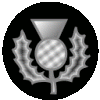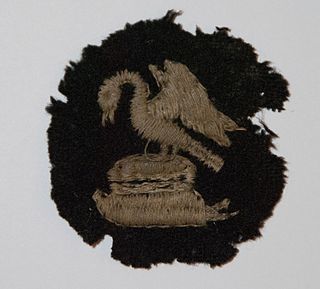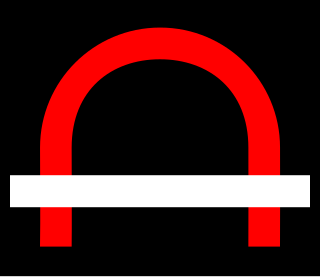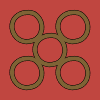
The 9th (Scottish) Division, was an infantry division of the British Army during the First World War, one of the Kitchener's Army divisions raised from volunteers by Lord Kitchener to serve on the Western Front during the First World War.

The 10th (Irish) Division, was one of the first of Kitchener's New Army K1 Army Group divisions, authorized on 21 August 1914, after the outbreak of the Great War. It included battalions from the various provinces of Ireland. It was led by Irish General Bryan Mahon and fought at Gallipoli, Salonika and Palestine. It was the first of the Irish Divisions to take to the field and was the most travelled of the Irish formations. The division served as a formation of the United Kingdom's British Army during World War I.

The 11th (Northern) Division, was an infantry division of the British Army during the First World War, raised from men who had volunteered for Lord Kitchener's New Armies. The division fought in the Gallipoli Campaign and on the Western Front. The division's insignia was an ankh or ankhus.
The 27th Division was an infantry division of the British Army raised during the Great War, formed in late 1914 by combining various Regular Army units that had been acting as garrisons about the British Empire. The division spent most of 1915 on the Western Front in France before moving to Salonika where it remained with the British Salonika Army for the duration of the war. In 1916 its commander Hurdis Ravenshaw was captured by an Austrian submarine whilst sailing to England. In 1918 in Salonika the division took part in the Battle of Doiran. It carried out occupation duties in the Caucasus in the post-war before being withdrawn from the region in 1919.

The 24th Division was an infantry division of the British Army, raised in September 1914 from men volunteering for Lord Kitchener's New Armies during the First World War. After almost a year spent training in England the division was sent to the Western Front between August and September 1915. It served in Belgium and France in the trenches of the Western Front for the duration of the war.

The 61st Division was an infantry division of the British Army raised in 1915 during the Great War as a second-line reserve for the first-line battalions of the 48th Division. The division was sent to the Western Front in May 1916 and served there for the duration of the First World War.

The 60th Division was an infantry division of the British Army raised during the First World War. It was the second line-formation of the 47th Division, and was the second of two such Territorial Force divisions formed from the surplus of London recruits in 1914.

The 18th (Eastern) Division was an infantry division of the British Army formed in September 1914 during the First World War as part of the K2 Army Group, part of Lord Kitchener's New Armies. From its creation the division trained in England until 25 May 1915 when it landed in France and spent the duration of the First World War in action on the Western Front, becoming one of the elite divisions of the British Army. During the Battle of the Somme in the latter half of 1916, the 18th Division was commanded by Major General Ivor Maxse.

The 34th Division was an infantry division of the British Army that was raised in 1914, during the First World War. The division was raised from volunteers for Lord Kitchener's New Armies, that was originally made up of infantry battalions raised by public subscription or private patronage. The division was taken over by the War Office in September 1915. It served in France and Belgium in the trenches of the Western Front for the duration of the war.

The 31st Division was an infantry division of the British Army. It was raised in the Great War by volunteers from Kitchener's Army and formed in April 1915 as part of the K4 Army Group and taken over by the War Office on 10 August 1915. Comprising mainly infantry battalions from Yorkshire and Lancashire, the division was sent to Egypt in December 1915 before moving to France in March 1916 and spent the remainder of the First World War in action on the Western Front. The 31st Division was the quintessential New Army division, being made up entirely of Pals battalions.

The 46th Division was an infantry division of the British Army, part of the Territorial Force, that saw service in the First World War. At the outbreak of the war, the 46th Division was commanded by Major-General Hon. E.J. Montagu-Stuart-Wortley. Originally called the North Midland Division, it was redesignated as the 46th Division in May 1915.

The 21st Division was an infantry division of the British Army during World War I, raised in September 1914 by men volunteering for Lord Kitchener's New Armies. The division moved to France in September 1915 and served on the Western Front for the duration of the First World War. The divisional insignia was the "triple-seven".

The British 30th Division was a New Army division that was originally made up of battalions raised by public subscription or private patronage. The division was taken over by the British War Office in August 1915 and moved to France in December. It served on the Western Front for the duration of the First World War.

The 41st Division was an infantry division of the British Army, raised during the First World War as part of Lord Kitchener's New Armies. The division saw service on the Western Front and later on the Italian Front.

The 33rd Division was an infantry division of the British Army that was raised in 1914, during the First World War. The division was raised from volunteers for Lord Kitchener's New Armies, that was originally made up of infantry battalions raised by public subscription or private patronage. The division was taken over by the War Office in September 1915. It served in France and Belgium in the trenches of the Western Front for the duration of the war. The division's insignia was the "double-three" from a set of dominoes.
The 28th Division was an infantry division of the British Army raised for service in World War I.
The 26th Division was an infantry division of the British Army during World War I. The division was created in September 1914 from men volunteering for Lord Kitchener's New Armies and was the last division to be raised under the K3 enlistment scheme. Although the 26th Division began to assemble in September 1914, it was not fully deployed on the Western Front until the following year. In November 1915, the division was redeployed to the Macedonian Front, where it remained until the end of the war.

The 57th Division was an infantry formation of the Territorial Force created in 1914 as part of the massive expansion of the British Army during the First World War. It served on the Western Front during 1917 and 1918. The divisional number was reactivated for deception purposes during the Second World War.

The 58th Division was an infantry division created in 1915 as part of the massive expansion of the British Army during the First World War. It was a 2nd Line Territorial Force formation raised as a duplicate of the 56th Division. After training in Britain, the division joined the British Expeditionary Force (BEF) on the Western Front in 1917. It saw action at the battles of Arras and Passchedaele in 1917 and the German spring offensive in 1918. It then took part in the Battle of Amiens and the final Allied Hundred Days Offensive of the war. The division was recreated during the Second World War, as an imaginary deception formation.

The 59th Division was an infantry division of the British Army during World War I. It was formed in late 1914/early 1915 as a 2nd Line Territorial Force formation raised as a duplicate of the 46th Division. After training in the United Kingdom and saw service in the Easter Rising in April 1916, the division joined the British Expeditionary Force (BEF) on the Western Front in early 1917. It saw action at Ypres and Cambrai, and was almost destroyed during the German Army's Spring Offensive in March 1918. The reconstituted division took part in the final advances of the war.




















